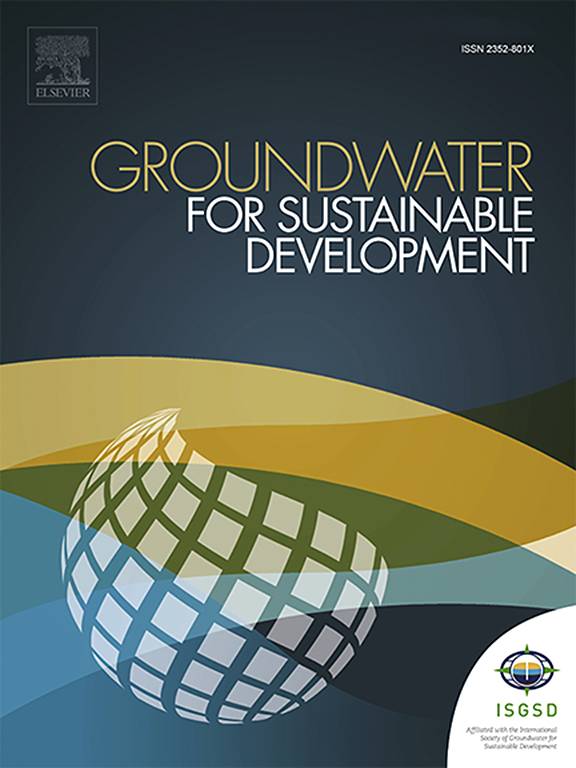Control of Al2O3/TiO2 sorbent synthesis parameters to enhance fluoride remediation of impaired water resources
IF 4.9
Q2 ENGINEERING, ENVIRONMENTAL
引用次数: 0
Abstract
Alumina is widely used for fluoride ion removal due to its high affinity but is limited by low uptake capacity and structural instability. To overcome these issues, innovative alumina-titania sorbents were developed using co-precipitation. These sorbents maintained a surface area of ∼260 m2/g and pore volume of ∼0.21 cm3/g regardless of feed flow rate. However, low NaOH molarity significantly increased surface area, peaking at 343 m2/g with 1 M NaOH. Aging also enhanced surface area, reaching ∼315 m2/g.
Equilibrium isotherms showed that a feed flow rate of 25 mL/min achieved the highest fluoride uptake (0.19 meq/g). NaOH concentrations ≤4 M produced favourable isotherm profiles, while ≥4 M resulted in unfavourable outcomes. Aging the synthesis mixture for 1–2 h was optimal, as extended aging reduced isotherm performance.
The Al2O3/TiO2 sorbents also removed calcium, magnesium, barium, strontium, potassium, and silica from groundwater. Optimal synthesis conditions were identified as a 25 mL/min feed flow rate, 2 M NaOH concentration, and a 2-h aging time. The sorption mechanism combined electrostatic attraction and ligand exchange, highlighting the potential of these materials for multifunctional water treatment.

控制Al2O3/TiO2吸附剂合成参数,加强对受损水资源的氟修复
氧化铝因其高亲和力而被广泛应用于除氟,但受吸收能力低和结构不稳定的限制。为了克服这些问题,利用共沉淀法开发了新型的氧化铝-二氧化钛吸附剂。无论进料流量如何,这些吸附剂的表面积保持在~ 260 m2/g,孔隙体积保持在~ 0.21 cm3/g。然而,低NaOH的摩尔浓度显著增加了表面积,当NaOH浓度为1m时,表面积达到343 m2/g。老化也增加了表面积,达到~ 315 m2/g。平衡等温线显示,进料流量为25 mL/min时,氟吸收量最高(0.19 meq/g)。NaOH浓度≤4 M产生有利的等温线曲线,而≥4 M则产生不利的结果。时效1 ~ 2 h为最佳,延长时效降低了等温线性能。Al2O3/TiO2吸附剂还能去除地下水中的钙、镁、钡、锶、钾和二氧化硅。最佳合成条件为进料流速为25 mL/min, NaOH浓度为2 M,老化时间为2 h。吸附机制结合了静电吸引和配体交换,突出了这些材料在多功能水处理方面的潜力。
本文章由计算机程序翻译,如有差异,请以英文原文为准。
求助全文
约1分钟内获得全文
求助全文
来源期刊

Groundwater for Sustainable Development
Social Sciences-Geography, Planning and Development
CiteScore
11.50
自引率
10.20%
发文量
152
期刊介绍:
Groundwater for Sustainable Development is directed to different stakeholders and professionals, including government and non-governmental organizations, international funding agencies, universities, public water institutions, public health and other public/private sector professionals, and other relevant institutions. It is aimed at professionals, academics and students in the fields of disciplines such as: groundwater and its connection to surface hydrology and environment, soil sciences, engineering, ecology, microbiology, atmospheric sciences, analytical chemistry, hydro-engineering, water technology, environmental ethics, economics, public health, policy, as well as social sciences, legal disciplines, or any other area connected with water issues. The objectives of this journal are to facilitate: • The improvement of effective and sustainable management of water resources across the globe. • The improvement of human access to groundwater resources in adequate quantity and good quality. • The meeting of the increasing demand for drinking and irrigation water needed for food security to contribute to a social and economically sound human development. • The creation of a global inter- and multidisciplinary platform and forum to improve our understanding of groundwater resources and to advocate their effective and sustainable management and protection against contamination. • Interdisciplinary information exchange and to stimulate scientific research in the fields of groundwater related sciences and social and health sciences required to achieve the United Nations Millennium Development Goals for sustainable development.
 求助内容:
求助内容: 应助结果提醒方式:
应助结果提醒方式:


